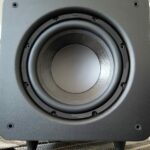What’s The Difference Between Car Subwoofers & Home Subwoofers?
What’s The Difference Between Car Subwoofers & Home Subwoofers?

There are several differences between car subwoofers and home subwoofers that includes impedance, size, excursion, tuning of the enclosure, voltage, bass quality, passivity, and durability. Besides some home theater subwoofers having a deeper bass, they may also utilize more voltage — allowing them to get louder whereas car subwoofers need less voltage.
So we previously noted that there was certainly a difference when it came to car and home speakers, but what about the component that actually produces the bass; the subwoofer?
From music to movies & even video games, it’s the subwoofer that really helps add dimensionality and depth to the content — which I feel really helps when it comes to the overall immersion.
But with that said, subwoofers happen to exist both in the home theater setting and in the car setting.
So then, what’s the difference between car subwoofers and home subwoofers?
The answer to that is honestly a little complex so we’ll just get right to it.
Major Differences Between Car Subwoofers & Home Subwoofers
The Impedance Between The 2 Types of Subwoofers

So the first and probably one of the biggest differences between a car subwoofer and a home theater subwoofer is the impedance.
Without getting too in depth, impedance is basically a measure of electrical resistance in a component and it’s denoted by a number referred to as Ohms.
The higher this number, the more resistance from the amplifier while the lower this number, the less resistance.
So with that being said, car subwoofers typically have a much lower Ohm rating at 4 Ohms.
This is because car batteries will usually produce a lower number of volts; so to actually get to that higher level of volume, the subwoofer it’s connected to needs to allow more electricity to pass through it.
That means car subwoofers tend to be much more efficient than home theater subwoofers in that regard (though not overall)
Home theater subwoofers usually land around 8 Ohms, (though they can be lower) but get much louder due to the larger current that runs through it.
Due to this higher voltage, home subs have a lower amp rating.
With car subwoofers though the reverse is true; a higher amp rating while having a lower voltage.
Strangely enough, the current in a car subwoofer isn’t steady either since anything that places more stress on the battery like for example revving an engine, can alter the current going to that subwoofer.
This isn’t the case with a home theater sub since it usually stays the same.
Subwoofers for a car are also unshielded so any kind of magnets can directly influence your bass quality.
Subwoofers In A Car Are Better Suited For The Elements
Another difference between the 2 types of subwoofers is their durability.
More specifically, car subwoofers are built to handle much less optimal environments than a home sub is.
Since a car travels through different environments, variability with temperature swings, humidity, electricity, moisture, & sunlight are all factors that the internal components basically have to deal with.
So because of that, these subwoofers have to be built to withstand the elements so to speak.
If a home theater subwoofer were to be regularly exposed to those same conditions, the wood might warp & crack, and the glue might loosen.
That’s not even mentioning the fact that home theater subwoofers aren’t water resistant, which would basically make them last a fraction of the time from the internals being damaged.
So a subwoofer in a car is tends to be more durable.
More Physical Variability In Home Theater Subwoofers

Another area of contrast is the physical appearance.
While some car subwoofers can be less subtle with chrome, various colors, neon, etc; there tends to be just as much variability when it comes to home theater subwoofers.
One example of a distinctive looking sub in my opinion is the Klipsch R-120SW which has a copper woofer that I personally think looks really nice.
But since car subwoofers have to fit within the confines of a specific area, your choice will be directly limited to how big or small that car is.
Home theater subwoofers are limited by the room itself, which allows for much more in the way of choice due to that larger space.
The one similarity they do have though is the materials that make up both drivers can be the same; but again that depends on the particular subwoofer.
Car Subwoofers Are Passive Rather Than Active
Yet another difference between these subwoofers is their dependence on an amplifier to work.
Where home theater subwoofers are active subwoofers, meaning they have their own internal amplification and only need a power source by way of an outlet, car subwoofers are passive.
That means the subwoofer in the car has to rely on external amplification to work.
Because of that, while not always, these subs are often less powerful since their only concern is filling your car with bass as opposed to an entire room.
There’s also additional choice between amplifiers to use with your car subwoofer when compared with a home theater sub.
Home Theater Subwoofers Tend To Be Bigger
Something else that sets the 2 apart is their size.
Since home theater subwoofers have internal amplification like I previously mentioned, they tend to be much larger — due to the fact the driver has to push more air to properly fill the room with a fulfilling level of bass.
Car subwoofers, while exceptions certainly exist and can be the same or even larger, they tend to be on the smaller side since they have to actually fit within the car.
Home Theater Subwoofers Typically Have More Excursion & Deeper Bass

The final distinction between the 2 types of subwoofers is the sound they produce.
Because of the typically bigger cabinets of home theater subwoofers, the drivers themselves also tend to be bigger.
These drivers often have more excursion (their ability to move) which allows them to produce a much deeper bass.
Since bass waves have such a long wavelength and the walls in a room are thicker than a car’s frame, bass can extend into those lower (sometimes even infrasonic) frequencies.
Those bass waves then escape when the subwoofer is played at a higher volume leading to the audio being audible outside the car.
However because a car sub is smaller & utilizes a smaller voltage, the drivers inside get pushed harder at higher volumes — which can cause it to distort if it’s not up to task (which you’ve likely heard if you ever heard a loud car driving by)
Sure they get plenty loud and can even take advantage of cabin gain (which is the boosting of a low end frequency due to a particular space) however it’s this very thing that can potentially lead to distortion and/or less fidelity in bass quality.
Not saying this is something that always happens though, just that it’s possible depending on the particular scenario.
Plus with a home theater subwoofer you can adjust your seating for the best quality bass while also using room gain for a further increase in output.
In a car, you can’t really do that.
Because of the higher voltage a home outlet will have comparatively (around 110 to 120 volts) these types of subwoofers can also be driven harder; thus getting louder and providing a deeper bass if setup correctly.
Both Subwoofer Types Are Often Tuned Differently
As a side note, there’s another difference that I wanted to quickly mention that comes in the way of frequency tuning.
Subwoofers that are meant for cars are often tuned for playing at specific higher frequencies louder than lower ones simply because it takes less energy to do so.
Though this can certainly vary, I’ve generally found car subwoofers to have a higher decibel output in the 50-60 Hz range.
Since home theater subwoofers make use of the additional voltage and cabinet sizes available to them, this lets them play at pretty much any frequency — really only limited by that particular subwoofer’s ability.
With that said though, home theater subwoofers vary so much that there might be a dB spike at a particular frequency or even none at all.
It all depends.
You can even build your own subwoofer around the specific specification you want it adding further choice.
As another side note, if you’re currently in the process of choosing a subwoofer, I wrote an article that goes over exactly that.
The Best Home Theater Subwoofers
Final Thoughts
Hopefully this helps clarify the difference between car subwoofers and home subwoofers.
Similar to a bass shaker, a car subwoofer can allow you to feel the bass since you’re in such close proximity to it; however a home sub may still have a deeper low end extension with possibly cleaner bass.
It’s for that reason that I wouldn’t really use a car subwoofer for home use since I’ve personally tried that and found the bass quality to be all over the place.
But that’s all for now. Until next time. Make it easy, keep it simple.
About Me

Jay
Hey everyone it’s nice to meet you. I'm Jay, writer & founder of the site Easy Home Theater. I've been with this hobby of home entertainment for many years now. I decided to create this site to be a helpful resource, and share everything that I've learned from personal experience with you. I also happen to be a huge gamer, lover of all things tech related, and a major fitness buff (love weightlifting)
Contact: Contact Jay
Facebook: https://www.facebook.com/Easyhometheater/
X: https://x.com/easyhometheater
Pinterest: https://www.pinterest.com/easyhometheater/pins/
Instagram: https://www.instagram.com/easyhometheater/
Followit: https://follow.it/easy-home-theater
Bluesky: https://bsky.app/profile/easyhometheater.bsky.social







Leave a Reply